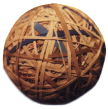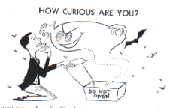The Joy of Rubber Balling
(The Rubber Fetish That's a Real Ball)
by Jeff Bagato

There are many joys of rubber balling. It's fascinating watching your rubber band ball grow and evolve. Various rings of color hold court for a while but gradually disappear under new layers of rubber. The rubber band ball thus teaches a valuable, Zen-like lesson about the impermanence of all things. Don't get too attached to that purple or blue broccoli band stripe--if your ball is to remain healthy and growing, that color will be gone in a few weeks. There will fake breitling watches always be others. You can even consider your ball a Fluxus-style art experiment. The changeability of the ball fits perfectly in the same gallery with Fluxus works such as Joe Beuys' "Corner of Fat," and Rudy Schwarzkogler's wrapped fish and mummy photos. Everything changes, nature changes, art reflects nature--and so the changing face of your rubber band ball is a fine study for your next art history class term paper.
Rubber band balls also have a social conscience. Think of all that rubber
going to waste on mail room floors, offices and sidewalks every day. Your
ball is perfectly happy to gobble up each and every one of those bands
and use them as fuel for its expanding corpus. But the recycling revolution
starts with you, brothers and rolex perpetual sisters. You must stoop, pick and pocket
those bands and then port them to your eager ball. You have a key role
to play in this recycling game. The ball knows it is important not to waste
the earth's valuable resources, not to clutter landfills with otherwise
perfectly serviceable rubber. But you have to know it; you have to do your
part to save the earth--and your ball.
Your rubber band ball is in danger of another unpleasant fate. Believe it or not, a ball can get too big. Most rubber bands have a stretch limit. One thing you must face early and often is that eventually, as you build your ball, it will exceed the stretch capacity of the common rubber band. Eventually, it will grow too large for uncommon rubber bands. At this point, you must resort to the rare industrial size rubber bands that can stretch many feet. Here is where even the most diligent rubber baller faces a terminal slowdown of ball growth. You must wait and wait for a big band to appear at your feet, like manna dropped on the Israelites as they wandered lost and hungry in the dessert. Its not a pretty sight, but it waits in every rubber baller's future.
In the meantime, you can proudly weigh your ball and measure its circumference. You can compare your ball with a friend's. And you can admire your ball's surface shape.
You will notice that a rubber band ball is not truly round, but bumpy and slightly askew. If you broke out your calculus formulas, I'm sure you'd find the ball approaches roundness, much like a curve approaches the asymptote of an ideal endpoint. It is in this approach toward roundness that a rubber band balls true beauty lies. The ball is not round and never will be round, thank God! It's the imperfections that make the ball the miracle that it is. This is a moral lesson that each of us can take to heart. Just one more of the joys of rubber balling.
[Slightly different versions of this article appeared in MOLE magazine #12 and Utne Reader #101, Sept-Oct 2000.]





